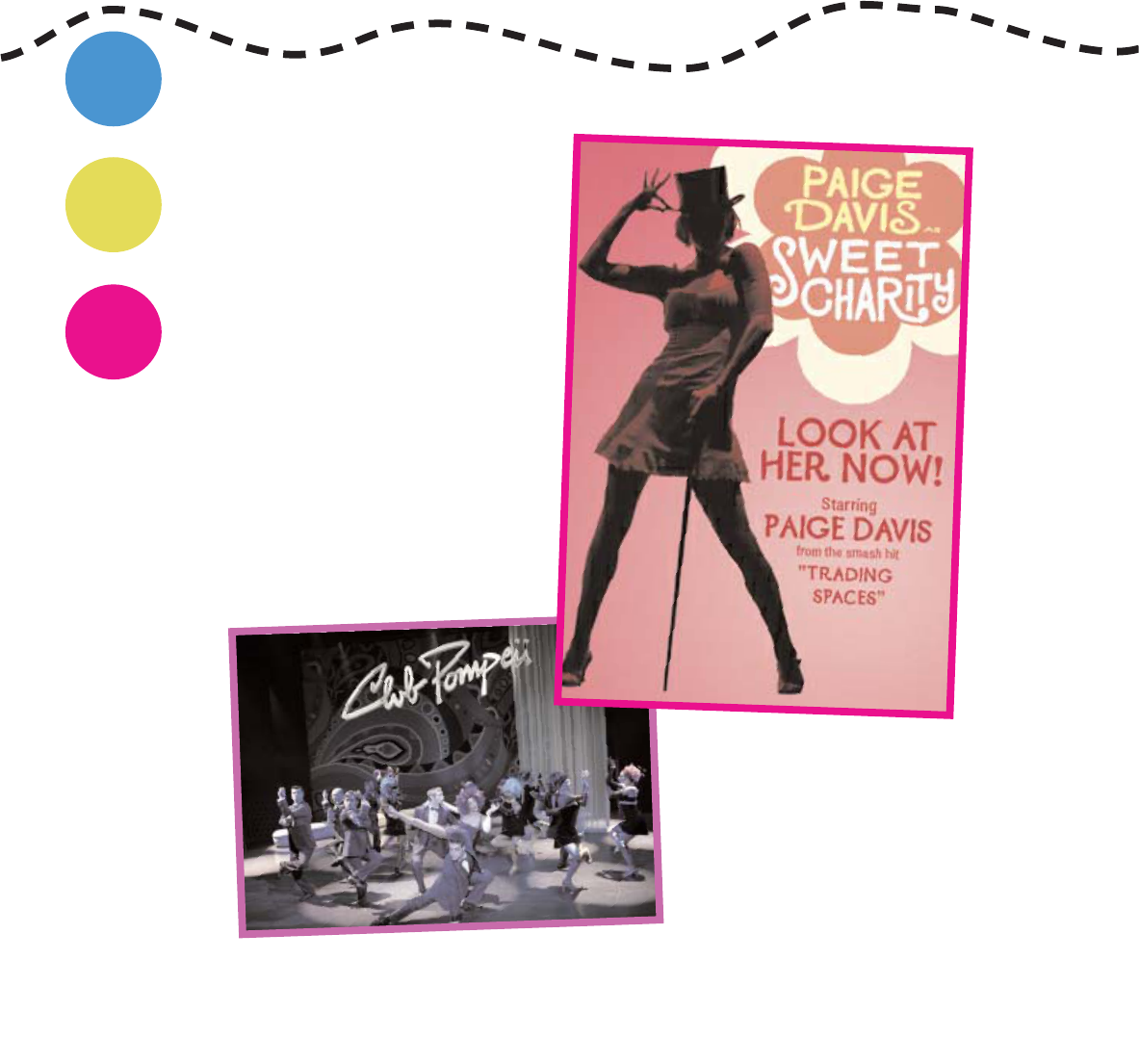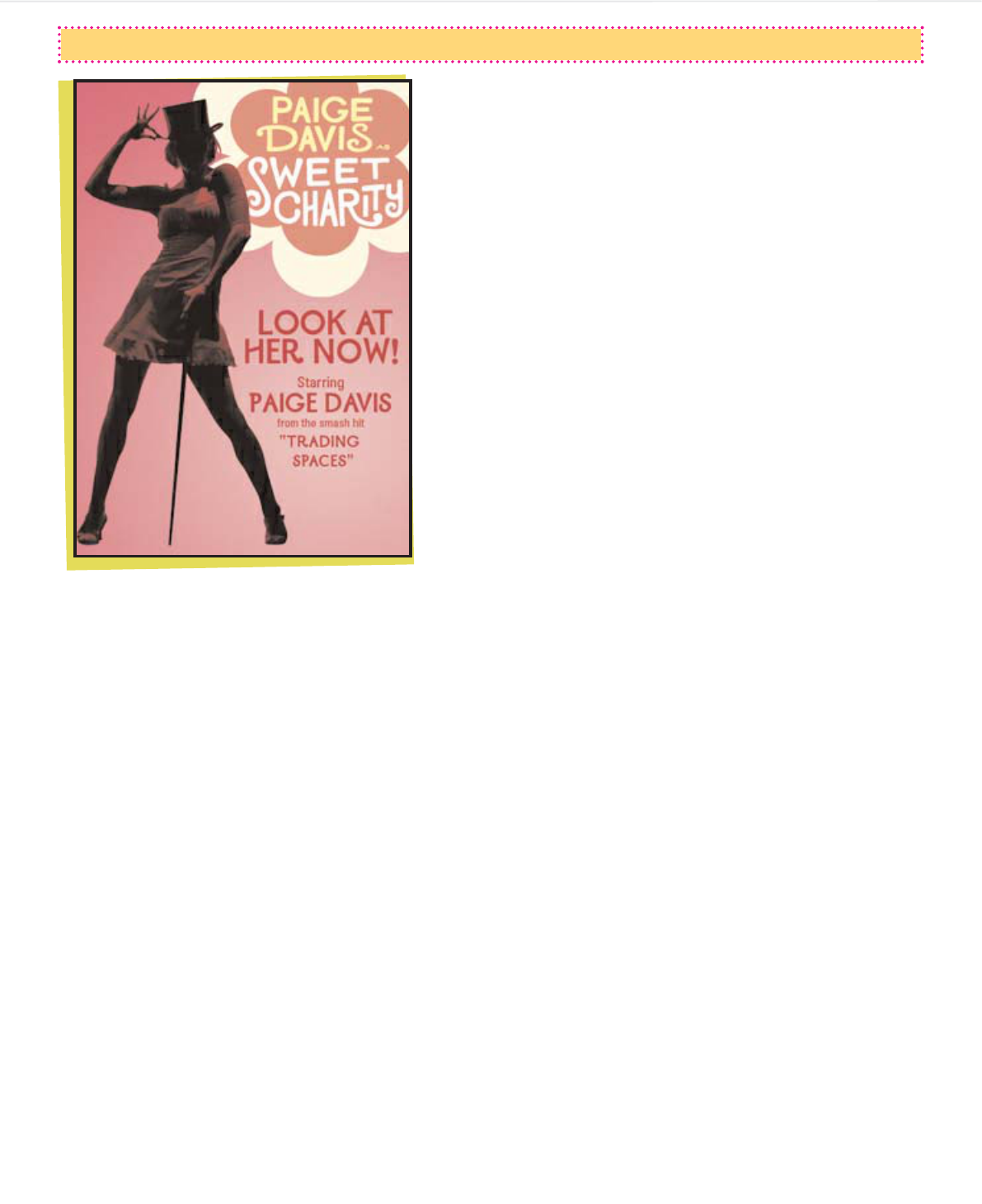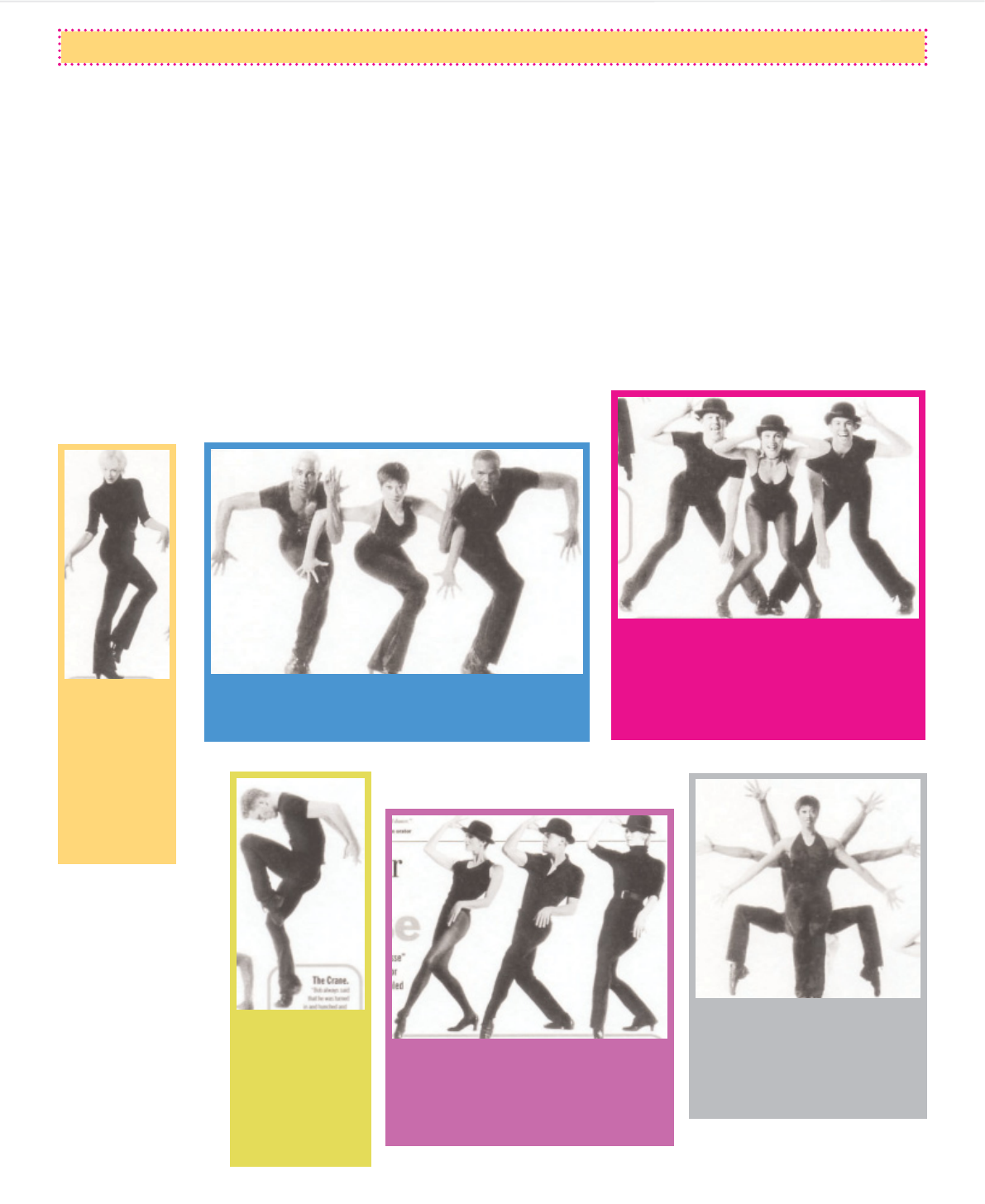
Sweet Charity
Sweet Charity
E
E
ducational
ducational
S
S
tudy
tudy
G
G
uide
uide
T HEATRE U NDER T HE S TARS
800 BAGBY, SUITE 200
H OUSTON, TEXAS 77002
Contains Mature Language

Page 1: Brief History of TUTS
Page 1: Purpose of Study Guides
Page 2: What is Musical Theatre?
Page 2: History of Musical Theatre
Page 3: Elements of Production
Page 4: Stage Diagram
Page 4: How is Musical Theatre Different from Other Media?
Page 4: Why is Musical Theatre Important?
Page 5: Glossary of Terms
Page 6: Theatre Etiquette
Page 7: How A Musical Is Born
Page 8: Review Questions
Page 9: Review Activities
Page 10: Show Background
The Creative Team
Page 11: Character List and Song List
Page 12: Show Synopsis
Page 13: Digging A Little Deeper
Literary Terminology
Discovering the Story
Page 15: Bob Fosse and A New Jazz Dance
Page 16: Get Creative!
a. Two Thumbs Up!
b. Test Your Knowledge
c. You’re The Writer
d. Stars Are Born
Page 17: Word Search Hand-out
Page 18: Word Search Answer Key
Page 19: Crossword Puzzle Hand-out
Page 20: Crossword Puzzle Answer Key
Page 21: Mini Quiz Hand-out
Page 22: Mini Quiz Answer Key
Page 23: PBS’ Stars Over Broadway: Bob Fosse
Page 24: Jazz Dance: A Brief Overview
Page 25: Song Lyrics
Big Spender
I’m A Brass Band
Where Am I Going?
If My Friends Could See Me Now
SECTION ONE: Introduction
SECTION TWO: Musical Theatre 101
SECTION THREE: About the Show
SECTION FOUR: Middle & High School Curriculum
SECTION FIVE: Supplemental Material
T
able
o
f
C
ontents
Sweet Charity
Educational Study Guide
Theatre Under The Stars
Houston, Texas
Written by
Alicia Hodge
x -- Table of Contents -- Sweet Charity Study Guide

Theatre Under The Stars (TUTS), founded in 1968 by Frank M. Young, is Houston's acclaimed musical theatre production company.
During its 34 seasons, TUTS, one of America's largest non-profit producers of musical theatre, has produced a total of 39 Premieres,
including 11 World Premieres, one U.S. Premiere, three Southwest Premieres, and 24 Houston Premieres.
TUTS' name originates from performing in its first venue, the Miller Outdoor Theatre in Hermann Park. This outdoor setting truly
provided spectators "theatre under the stars." TUTS was the first theatrical organization in Houston to perform free to the public
at the Miller and has since performed there each summer, giving Houston 42 lavish musicals in total. TUTS is the only Houston arts
institution to perform every summer without interruption since the theatre opened in 1968. In July 1999, TUTS set a Miller Outdoor
Theatre all-time attendance record with an audience of 91,000 for Grease.
TUTS established the Humphreys School of Musical Theatre (HSMT) in 1972 as its official training wing. Today, HSMT continues to
provide instruction and stage experience for more than 1,000 students annually. Established with a grant from the Humphreys
Foundation of Liberty, Texas, HSMT trains students, ages four through adult, in acting, voice, dance and musical theatre technique
during school semesters and through on-going workshops. Students perform in a fully-staged end-of-term musical and may audition
for juvenile roles in TUTS' major musical productions.
Purpose of
Study
Guides
TUTS has designed online study guides such as this one to enhance students' theatrical experiences. Using the guide, teachers can
encourage their students to explore both the story and the production elements of the show. Live theater can enrich young peo-
ples’ lives like few other experiences. The study guides contain various discussion questions, projects, and activities that allow
students to engage in literary analysis, historical research, and personal reflection. TUTS' hope is that these young people will be
able to gain a greater understanding and appreciation for musical theatre.
“No child is fully educated or adequately prepared to live
in an increasingly technological world without understanding
the meaning and beauty transmitted by the arts.
”
J.P. Getty Trust
Beyond Creating a Place for Art in America’s School, 1985
1 -- Introduction -- Sweet Charity Study Guide
History of
Theatre
Under
The
Stars
1
Section
Introduction

The origins of the musicals trace all the way back to story telling ballads. The ballads were stories in songs, passed down orally
from generation to generation. In 1597, Dafne, the first opera emerged. Like ballads, opera told stories through music. However,
opera is written down and performed on stage. And from opera, the operetta, literally meaning "little opera", developed. Relative
to its predecessor, operettas dealt with less serious topics and used more dialogue. Finally, in 1866, the very first musical, The
Black Crook by Charles M. Barras and Giuseppe Operti, was performed in New York. However, American musical theatre did not
establish its own identity until after the turn of the 20th Century.
George M. Cohan--librettist, lyricist, and composer, was a powerful influence in creating a truly native musical art form. Not only
were the settings and characters of Cohan's musicals thoroughly American, but his dialogue, lyrics, and melody had the spirit of
energy and pride that were unmistakably American. Cohan also established some of the procedures governing musical-comedy
writing. Any plot, however improbable, was possible just so long as it could be the frame for songs and dances. For many years,
American musicals were governed by this principle.
However, efforts were made to break loose from the rigid formula. The greatest revolu-
tion in American musical theatre up to that time came in 1927 with Show Boat, by
Oscar Hammerstein II and Jerome Kern. The show featured popular music, such as jazz
and gospel, which separated Show Boat from both operetta and all the musicals before
it. Here was a complete integration of song, humor, and production numbers into a sin-
gle and inextricable artistic entity; a musical with a consistent and credible story line,
authentic atmosphere, and three-dimensional characters.
Then came the first of the Rodgers and Hammerstein masterworks, Oklahoma!, in 1943,
with which musical theatre finally became a significant American art form. According to
Rodgers, "By opening the show with the woman alone onstage and the cowboy beginning
his song offstage, we did more than set a mood; we were, in fact, warning the audi-
ence, 'Watch out! This is a different kind of musical." The national tour of Oklahoma!
ran for an unprecedented ten years, playing before a combined audience of more than
ten million people. In 1955, Oklahoma! was made into a film where it also found great
success.
During the late 1950's and early 1960's, popular music began to change when rock 'n roll
became more mainstream. This trend influenced musicals such as West Side Story
(1957) and Bye Bye Birdie (1960) to feature more popular, contemporary music. Hair in
1968 continued this movement by incorporating rock music with storylines based on the hearts of the younger generation.
And setting a pattern that would redefine Broadway, Cats premiered in 1982, introducing opulent sets, extravagant costumes and
makeup, and over-the-top special effects. The visual spectacle was unlike the painted backdrops and simple costumes seen in the
past. The trend continued with shows like The Phantom of the Opera, Les Misérables, Miss Saigon, and The Lion King.
Then came Rent in 1996, which revolutionized the very concept of musical theatre around the world. Rent blended pop, dance,
salsa, rhythm and blues, gospel, and rock music together to tell its moving tale of hopes and dreams, while also addressing the
serious and controversial issues of homelessness, AIDS, and drug addiction. Rent not only challenged the mainstream, but reinvent-
ed it. Shows following Rent, such as Ragtime (1998) and Wicked (2003), also contained intricate storylines, unique styles of music,
and visual spectacle, while continuing to address social and political issues.
Musical theatre is defined as the presentation of a story using the elements of music, singing, and dance on a stage in front of a
live audience. This art of telling stories either through or with songs dates back to time immemorial. The ancient Greeks included
music and dance in many of their stage comedies and tragedies as early as the 5th Century B.C. Staged in open-air amphitheaters,
these plays featured humor, political and social satire, jugglers, and anything else that might entertain the masses. While these
plays had no direct effect on the development of musical theatre as we know it, they prove that musicals have been around for at
least 2500 years.
2 -- Musical Theatre 101 -- Sweet Charity Study Guide
History of
Musical
Theatre
What is
Musical
Theatre?
2
Section
Musical Theatre 101

Crew: The set designer creates the locale and period in which the musical occurs.
While some sets are very simple and focus the audience's attention on the show itself,
some are lavish and extravagant providing visual appeal. The head carpenter
is
responsible for building the actual set. The lighting designer decides where the light-
ing instruments should go, how they should be colored, and which ones should be on at
any particular time. The electrician
implements the lighting designer's work and makes
sure the lights are set properly and safely. The property (props) master is in charge of
obtaining or making and maintaining all props used in the show. He or she also sets the
props in their proper places before the show begins. There is also a flyman, who oper-
ates the flying system (if necessary), and controls the raising and lowering of back-
drops, light set pieces, and the curtain itself. When young performers (18 and younger)
need extra guidance and direction, the child wr
angler helps them through the
rehearsals and production for a smooth and successful show. The stage manager
is
responsible for the overall integrity of a production. He or she assists the director by calling out forgotten lines during rehearsals,
and “calls the show”, making sure each performance runs as smoothly as possible.
Sound: The sound designer plans the layout of all sound playback and equipment for the show and adjusts the pitch, volume,
duration, and overall quality of the music to meet each specific scene's needs. The sound oper
ator executes the sound designer's
plans and handles the mixing equipment for the show. Music and sound must fit the context in which they are used. The adjust-
ments are made using the soundboard. The sound effects designer is responsible for creating or enhancing sounds distinct from
music and dialogue, such as doorbells or running water.
Costumes and Make-up: The costume designer first researches the setting of the musical. Costumes must be appropriate
for the time period and culture of the show, beautiful and elaborately designed, while also practical enough to all for movement
and dance. He or she then decides which styles and fabrics to use, and draws the costumes in renderings. Through costume fit-
tings, the tailor
adjusts the outfits to fit each individual performer. During dress rehearsals and performances, actors have
dressers to help put on his or her costume. The ensemble or chorus members also have dressers to help them change during quick
character or scene transitions. The make-up artist
is responsible for applying cosmetics to each performer's face and body to
increase visibility, enhance certain features, and modify the actor's look to resemble his or her character. In addition to make-up,
certain roles call for a specific hairstyle. The wig master/mistress obtains the wigs, styles and shapes them, and helps the actors
put them on.
Elements of
Production
3 -- Musical Theatre 101 -- Sweet Charity Study Guide
A musical is much more than the two and a half hour show the audience sees. The production process often takes many months,
even years, to complete.
Creative Team The Cast
The Rehearsal
No musical would be possible with-
out the imagination or inspiration
of its authors. Many times, the idea
for a show grows from an existing
book, play, article, or movie. Other
times, authors write musicals from
an original idea or concept. Once
an idea is developed, composers
and lyricists begin to write the
songs. The music needs to not only
fit the overall tone and pace of the
musical, but also contain lyrics that
help the audience understand the
story and its characters. The chore
-
ographer designs dance sequences
for the performers. The dances are
intricate movements that allow the
performers to express the meaning
of each song. The director
works
with all of them to help guide the
overall artistic vision of the show.
The director works with the casting
agent to cast both the principal
performers and the ensemble or
chorus members. Each performer
must have a well-trained singing
voice, acting skills, the ability to
dance, and fit the look of his/her
character. These elements are all
evaluated during the audition
process. Actors are asked to bring a
headshot
as well as perform two
pieces, one uptempo song and one
ballad
. Those who are not chosen
for a principal role through the
auditioning process sometimes
become standbys
or understudies,
who take over the part when the
leading actor is unable to perform.
There are also swings, who serve as
backups for ensemble or chorus
members.
The cast will do an initial read-
through of the script, without
singing or dancing, followed by addi-
tional practices with the rehearsal
pianist. The music director or con
-
ductor teaches and rehearses the
music with the orchestra and is
responsible for the musical aspect of
the production. The dance captain
,
sometimes together with the chore-
ographer, teaches and rehearses the
dance sequences with the perform-
ers. During rehearsals, the director
coaches the actors' reading of the
lines and emotions and also gives
them their blocking
, line by line,
scene by scene. Next, the cast does
a sitzprobe, where they sit and sing
with the orchestra before incorpo-
rating any staging, scenery, cos-
tumes, or props. Eventually, the cast
does a wanderprobe
, where they
run through the show, including
movements and dancing, while the
orchestra plays. The technical
rehearsal is when the full cast and
crew walk through the entire show,
ensuring every light cue, sound
effect, microphone, etc. works as
planned. This rehearsal is mainly for
the tech staff. The cast and crew
will also go through a dress rehears
-
al, many times to bring all the dif-
ferent elements (costumes, music,
dance, lights, sound) together.

Audience: At the front of the theater, audience members will see a marquee displaying the name of the show being per-
formed that night. After purchasing tickets at the box office
and entering the theater, audience members will receive a program,
which provides information about the show, actors' biographies, a song listing, characters, scenes, and possibly a synopsis. An usher
escorts them to their seats, which may be in the boxes, orchestr
a, mezzanine, or gallery sections. Each show begins with the
overture and is separated into two acts by a fifteen-minute intermission. At the end of intermission, the entr'acte plays, signaling
the start of Act II. The show ends with the finale or curtain call. Audience members will then give a standing ovation, if they felt
the show was exceptionally good. The house manager oversees all aspects of the audience, including supervising the ushers and
contacting the stage manger about any audience delays for starting the show or ending intermission.
How is
Musical
Theatre
Different
from
Other
Media?
The live theatrical experience not only involves the actors on stage, it also involves the audience in ways that film and television
do not. In reality, although the audience is sitting in an auditorium and the actors are on stage, there is very little separating the
audience from the performers. How the audience reacts to the show deeply affects the actors. Something seemingly trivial like
whispering or unwrapping a piece of candy can distract the actors and alter the mood and tone of their performance. Another dif-
ference of film, video or television is that the camera and editing define what the audience sees. In the theater, however, each
member of the audience works as a camera and editor, choosing his or her personal points of focus. The wonders of movies and
television are remarkable, but often provide an isolated experience. Being part of the communal magic when performer and audi-
ence connect at the theater cannot be duplicated.
Why is
Musical
Theatre
Important?
Musical theatre can help students grow academically, aesthetically and personally. Musical theatre writers, lyricists, and composers
have long looked to literature for their inspiration and subject material. As a result, students have the opportunity to engage in
literary analysis of both the story and its inspiration. Elementary students can begin to explore plot and characters, while junior
high and high school students can delve into theme, symbolism, and historical context.
Students will also have the opportunity to discover how music, dance, lighting, backdrops, etc. contribute to the show. Musical
theatre allows young people to explore the elements of production beyond television and film, and gain a greater appreciation for
the arts.
Musical theatre can bring students together, build confidence and solidarity, and stimulate discussion. Furthermore, with shows
that address political or social issues, musical theatre encourages young people to reflect on these issues, explore alternative
options for action, and build a personal commitment to change.
4 -- Musical Theatre 101 -- Sweet Charity Study Guide
Stage
Performer Point of View
Stage Right
Stage Left
Audience Point of View
House Left
House Right
Stage Diagram

Glossary of
Terms
Author - the writer of a musical script also called the book
Auditioning - to perform in order to get a role in the produc-
tion; usually includes singing, dancing, and reading scenes from
the show
Ballad
- a slow, romantic song for actors to showcase vocal clar-
ity
Blocking
- the specific movements of actors on stage
Box - a separate compartment of seats usually elevated on the
sides of the theater, for the accommodation of VIP's
Box Office
- a booth inside the theater where tickets are sold
“Calling the Show” - the process of calling out the lighting,
sound, and scene-change cues during a performance usually
done by the stage manager
Casting
- the process through which actors are chosen for roles
in the production
Casting
Agent - one who chooses actors for roles in the produc-
tion
Child W
rangler - one who works with child performers
Choreographer - one who designs dance sequences
Composer
- one who writes music
Conductor
- one who directs the orchestra
Dance Captain
- one who teaches and rehearses dance
sequences with the performers
Director - one who supervises the creative aspects and guides
the artistic vision of the production
Dress Rehearsal
- rehearsal in which performers practice with
costumes and props
Dresser
- one who assists performers with their costumes during
dress rehearsals and shows
Electrician
- one who works with the lighting designer to adjust
and operate lighting instruments
Ensemble / Chorus
- a group of singers, dancers, or actors who
perform musical numbers
Flyman - one who pulls the curtain before and after perform-
ances and operates the flying system, if one is used
Gallery
- the section of seats in a theater farthest away from
the stage; separated into front gallery and rear gallery
Head Carpenter - one who builds the sets for the production
Headshot
- a photograph of an actor from the shoulders up and
lists his or her credits on the back
House Left
- the left side of the theater, when facing the stage
(audience's point of view)
House Manager
- one who oversees all aspects of the audience;
responsible for ushers and audience safety
House Right
- the right side of the theater, when facing the
stage (audience's point of view)
Lighting Designer
- one who decides where the lighting instru-
ments should go, how they should be colored, and which ones
should be on at any particular time to affect mood, visibility,
and to showcase costumes and sets
L
yricist - one who writes the words to a song
Makeup Artist - one who applies cosmetics to a performer's
face and body
Marquee - a signboard projecting over the theater's entrance
Mezzanine
- the middle section of seats in a theater between
the orchestra and the gallery; separated into front mezzanine
and rear mezzanine
Music Director - one who teaches and rehearses the music with
the orchestra
Orchestra - the section of seats in a theater immediately
behind where the orchestra sits
Principal P
erformers - the leading actors, those who portray
the major roles
Progr
am
- a listing of the order of events, names of the cast
and crew, and other relevant information for the production
Property (Props) Master
- one who manages all items used on
stage that cannot be classified as scenery, electrics or wardrobe
Read-through - the cast reads through the script without move-
ment or music
Rehearsal Pianist
- one who plays the piano for early-stage
rehearsals
Set Designer
- one who creates the scenery for the stage
Sitzprobe - the first rehearsal with both the performers and the
orchestra, with no staging or dancing
Sound Designer
- one who plans and executes the layout of all
sound playback and equipment for the show
Sound Operator - one who handles the sound playback and mix-
ing equipment for the show; works with the sound designer
Sound Board
- a desk comprising a number of input channels
where each sound source is provided with its own control chan-
nel through which sound signals are routed into two or more
outputs; changes the quality of the sound
Sound Effects Designer
- one who creates or enhances sounds
that are not part of the music or dialogue
Standby / Understudy
- one who studies a role and is prepared
to substitute the principal performer when needed
Stage Left
- the left side of the stage, when facing the audi-
ence (performer's point of view)
Stage Manager
- one who is responsible for the quality of the
show's production, assists the director and oversees the show at
each performance
Stage Right
- the right side of the stage, when facing the audi-
ence (performer's point of view)
Swings
- one who is prepared to substitute for ensemble or cho-
rus members who are unable to perform
Tailor - one who alters garments to fit a person's specific meas-
urements
T
echnical Rehearsal - rehearsal incorporating the technical ele-
ments of a show, such as the scene and property shifts, light-
ing, sound, and special effects
Uptempo Song
- a fast, upbeat song for actors to showcase
dancing and acting ability
Usher - one who guides audience members to their seats
W
anderprobe - rehearsal in which the performers practice
singing and dancing on stage while the orchestra plays
Wig Master / Mistress - one who obtains and customizes wigs
for performers to wear
5 -- Musical Theatre 101 -- Sweet Charity Study Guide

Some basic theatre etiquette
tips:
1. Do not talk, whisper, sing, or
hum during the performance.
Singing and swaying with the
music or leaning forward in
your seat blocks the view of
those sitting behind you.
2. Do not eat and drink during
the performance. It is distract-
ing to both the performers and
your neighbors.
3. Keep feet on the floor, not
on the seat or balcony in front
of you.
4. Clap after the songs to show
the performers that you are
enjoying the show. Also keep
in mind that performers appre-
ciate enthusiastic applause,
but not whistling or shouting.
5. Appropriate laughter, tears,
and applause are the best ways
to express your feelings about
the performance.
6. Stay until the end of the
show and clap during the cur-
tain call to say "thank you" to
the performers.
7. No electronic devices should
be brought into the theatre,
and please silence all cell
phones, pagers and watches.
G
oing
t
o
t
he
T
heatre!
Some basic theatre etiquette
tips:
1. Do not talk, whisper, sing, or
hum during the performance.
Singing and swaying with the
music or leaning forward in
your seat blocks the view of
those sitting behind you.
2. Do not eat and drink during
the performance. It is distract-
ing to both the performers and
your neighbors.
3. Keep feet on the floor, not
on the seat or balcony in front
of you.
4. Clap after the songs to show
the performers that you are
enjoying the show. Also keep
in mind that performers appre-
ciate enthusiastic applause,
but not whistling or shouting.
5. Appropriate laughter, tears,
and applause are the best ways
to express your feelings about
the performance.
6. Stay until the end of the
show and clap during the cur-
tain call to say "thank you" to
the performers.
7. No electronic devices should
be brought into the theatre,
and please silence all cell
phones, pagers and watches.
G
oing
t
o
t
he
T
heatre!
Some basic theatre etiquette
tips:
1. Do not talk, whisper, sing, or
hum during the performance.
Singing and swaying with the
music or leaning forward in
your seat blocks the view of
those sitting behind you.
2. Do not eat and drink during
the performance. It is distract-
ing to both the performers and
your neighbors.
3. Keep feet on the floor, not
on the seat or balcony in front
of you.
4. Clap after the songs to show
the performers that you are
enjoying the show. Also keep
in mind that performers appre-
ciate enthusiastic applause,
but not whistling or shouting.
5. Appropriate laughter, tears,
and applause are the best ways
to express your feelings about
the performance.
6. Stay until the end of the
show and clap during the cur-
tain call to say "thank you" to
the performers.
7. No electronic devices should
be brought into the theatre,
and please silence all cell
phones, pagers and watches.
G
oing
t
o
t
he
T
heatre!
Use the following page about proper theatre etiquette during performances to copy and print out handouts for your students or
cut along the dotted lines to make reminder cards for students to keep with them throughout the show.
6 -- Musical Theatre 101 -- Sweet Charity Study Guide

How a
Musical
is
Born
The inspiration for a musical comes from many different places. Authors may conceive an idea themselves, or they might be com-
missioned by a producer to write a musical on a specific subject. Many times, musical theatre draws on material from existing
plays, books, movies, and other sources for a new show.
Screen to Stage: Screen-to-stage musicals are based
on existing movies. Authors adapt the material to fit musi-
cal theatre, possibly adding songs and changing dialogue.
Some examples of successful movie-turned-musicals are
Singin' in the Rain in 1985 (movie 1952), Beauty and the
Beast in 1994 (movie 1991), The Producers in 2001 (movie
1968), and Mary Poppins in 2004 (movie 1964).
Stage to Screen: Stage-to-screen musicals are musi-
cal theatre shows that have been made into movies.
Hollywood filmmakers choose popular musicals to guaran-
tee a hit movie. Though this is not always true, some suc-
cesses include Grease in 1972 (movie 1978), Chicago in
1975 (movie 2002), The Phantom of the Opera in 1988
(movie 2004), and Rent in 1996 (movie 2005).
Original / Concept Musicals: Concept musicals
are built around a single idea rather than a traditional plot.
Once a concept is raised (love, hate, friendships, relation-
ships, etc.), characters can comment on or act out various
aspects of the subject. There is a storyline, but it exists in
order to illustrate the central concept. Some well-known
concept musicals include Company (1970), A Chorus Line
(1975), and Assassins (2004). A revue could fall into this
category, like Swing! (1999) or Radio City Christmas
Spectacular (1933).
Revival / Revisal: While many musicals are revivals,
today is the age of the "revisal", when old musicals are
reinvented in new productions. The new shows usually have
the same basic storyline with revisions to the music and
artistic style. An example is Chicago (1996), which original-
ly premiered in 1975. A revisal is different from a revival in
that revivals make no change to the old production. For
example, Fiddler on the Roof premiered in 1964, and the
same production has been revived in 1976, 1981, 1990, and
2004, usually unchanged from the original.
Workshop Musicals: Unlike traditional musicals, workshop musicals do not have a single author and the plot is not
completely established before the production process begins. These musicals are developed by multiple members of the cre-
ative team through brainstorming sessions or "workshops". Workshop musicals are relatively new and are setting a new trend
for future shows.
Review Questions
1. Name the five types of musicals. Explain the advantages and disadvantages of each one.
2. What are some examples of stage-to-screen musicals? Screen-to-stage musicals?
3. If you were making a screen-to-stage musical, which movie would you choose and why?
4. How are workshop musicals different from all the other types?
5. If you were writing a musical, which type would you prefer to make and why?
7 -- Musical Theatre 101 -- Sweet Charity Study Guide

8 -- Musical Theatre 101 -- Sweet Charity Study Guide
Checking for Understanding
1. What is the definition of musical theatre?
2. How have the ancient Greeks contributed to
musical theatre?
3. How did George M. Cohan shape the
American musical?
4. Which was the first show to not follow
Cohan's formula? How was it different?
5. What do West Side Story, Bye Bye Birdie, and
Hair have in common?
6. How has Cats contributed to broadway?
7. What is the significance of Rent?
8. What are the three differences between
musical theatre and television or film?
9. How can musical theatre help people grow
academically? Artistically? Personally?
10. Name the eight major elements of produc-
tion and summarize each one.
11. What are four major theatre etiquette tips?
Review
Questions
The following questions are intended to help students learn the basics of musical theatre. These may be used for class discussion
or given as homework and written assignments.
Critical Thinking
1. What do you think are some major differ-
ences between ancient Greek theatre and
musical theatre as we know it today?
2. How did West Side Story, Bye Bye Birdie, and
Hair reflect young people's attitude in the late
1950's - 1960's?
3. What do you think Jonathan Larson, the
writer of Rent, hoped to accomplish by
addressing the issues seen in the musical?
4. The actors perform the same show each
night, but how could you make the experience
unique and personal to you?
5. What do you hope to gain from experiencing
musical theatre?
6. Is there one element of production that is
more important than all the others? Explain
your answer.
7. The audience does not participate in the
making of the show, so why are they important
to a musical production?
8. If you were to teach a child how to behave
at the theater, what would you tell them?

Review
Activities
9 -- Musical Theatre 101 -- Sweet Charity Study Guide
The following activities and projects are intended to encourage students to further their understanding of musical theatre, and
may also be used for class assignments or take-home projects.
E VOLUTION
OBJECTIVE
:
To learn the major shows throughout the histo-
ry of musical theatre
ACTIVITY: Have students create a timeline of the major
musicals (Show Boat, Oklahoma, West Side Story, Bye Bye
Birdie, Hair, Cats, Rent, Ragtime, Wicked). They can draw
or find and cut-out pictures to represent each one.
MATERIALS: Construction paper, crayons/markers/colored
pencils
I NSPIRATION
O
BJECTIVE:
To learn how historical context has affected
and inspired musical theatre, and develop research and
public speaking skills
A
CTIVITY:
Have students choose a musical to research and
then create a presentation of how the show reflects the
times in which it was created, including historical figures
and relevant social or political issues. Encourage students
to watch videos of the show, study song lyrics, and
research the time period in which the musical was written.
Suggested Shows: Oklahoma, West Side Story, Bye Bye
Birdie, Chicago, Annie, Rent
E VERYONE’ SAS TAR!
OBJECTIVE
:
To learn the elements of production in musical
theatre, stimulate imagination, develop teamwork skills,
and build self-confidence
ACTIVITY: As a class, choose a story and act it out, incorpo-
rating music with real or homemade instruments. Suggested
Stories: Hansel and Gretel, Little Red Riding Hood, Three
Little Pigs, Johnny Appleseed, Rapunzel, Rumpelstiltskin
MATERIALS: Homemade or real instruments, props (optional)
D EBATE
OBJECTIVE: To learn the differences between various
media, develop public speaking and verbal expression
skills, and encourage self-expression
A
CTIVITY:
Divide the class into three groups and have each
group choose a form of media (ex. television, movies, or
theatre). Then have the groups debate on which medium is
the best. Make sure students support their claims with spe-
cific benefits and limitations of each medium.
1
st
-
5
th
G
rade
6
th
-
12
th
G
rade

Show
Background
Sweet Charity, based on Federico Fellini's screenplay for Nights of Cabiria, is a musical choreographed and conceived by Bob
Fosse, with music by Cy Coleman, lyrics by Dorothy Fields, and book by Neil Simon. The original production directed by Fosse
opened on January 29, 1966 on Broadway at the Palace Theatre, and ran for 608 performances. It starred Gwen Verdon, John
McMartin, Helen Gallagher, Thelma Oliver, James Luisi, Arnold Soboloff, and Sharon Ritchie. The production was nominated for 12
Tony Awards, winning only one, for Fosse's choreography.
The 1969 film version of Sweet Charity, also directed and choreographed by Fosse, starred Shirley MacLaine and McMartin, recre-
ating his original Broadway role, as Charity Hope Valentine and Oscar Lindquist. The movie also included Chita Rivera, Paula Kelly,
Stubby Kaye, Barbara Bouchet, Ricardo Montalban, and Sammy Davis. The movie was notable for costumes by Edith Head, and also
the filming and editing of the dance sequences, most famously “Hey, Big Spender” and “The Rich Man’s Frug”.
Sweet Charity was revived on Broadway in 1986 starring Debbie Allen as Charity. It won four Tony Awards for Best Revival, Best
Featured Actor in a Musical (Michael Rupert), Best Featured Actress in a Musical (Bebe Neuwirth), and Best Costume Design
(Patricia Zipprodt). The most recent revival of the production was in 2005 starring television and film star Christina Applegate. It
opened on Broadway at the Al Hirschfeld Theatre on May 4, 2005. The show was nominated for many Tony awards including Best
Revival of a Musical and Best Actress in a Musical for Appelgate. The show ended its Broadway run on December 31, 2005, after
playing 279 performances. This production is part of the national tour of the 2005 Broadway revival which began in September
2006.
10 -- About the Show --Sweet Charity Study Guide
3
The Creative
Team
Section
About The Show
Bob Fosse
Choreography By
Bob Fosse, born June 23, 1927, was an American musical theater
choreographer and director. His career in dance began at an early
age when his father taught him ballroom dancing. Fosse began his
dance training at the Frederick Weaver Ballet School where he
learned tap and acrobatic dancing, and was the only male enrolled.
In 1946, he worked as a choreographer in his first two Broadway
shows, The Pajama Game (1954), in which he first met Gwen
Verdon, and Damn Yankees (1955). Fosse developed a jazz dance
style that was immediately recognizable, exuding stylized move-
ments. Fosse earned many awards for his works. Among them were
a Tony Award for Pippin, the Academy Award for Directing for
Cabaret and an Emmy Award for Liza with a Z. He was the first per-
son to win these three most important awards in the same year.
Fosse died on September 23, 1987.
Cy Coleman
Music by
Cy Coleman, born June 14, 1929, was an American composer, song-
writer, and jazz pianist. Coleman was a child prodigy who gave
piano recitals at Steinway Hall, Town Hall, and Carnegie Hall
between the ages of six and nine. Before beginning his fabled
Broadway career, he led the Cy Coleman Trio, which made many
recordings and was a much-in-demand club attraction. Coleman's
winning streak as a Broadway composer began when he collaborat-
ed on Wildcat (1960), which marked the Broadway debut of Lucille
Ball. In the late 1970s, he collaborated on I Love My Wife (1977)
with Michael Stewart and On The Twentieth Century (1978) with
Betty Comden and Adolph Green. In 1980, Coleman served as pro-
ducer and composer Barnum, which introduced Jim Dale and Glenn
Close. In 1990s, Coleman composed The Will Rogers Follies (1991)
and The Life (1997). Coleman died on November 18, 2004.
Dorothy Fields
Lyrics by
Dorothy Fields, born July 15, 1905, was an American librettist and
lyricist who wrote well over 400 songs for Broadway musicals and
films. She had great talent to match colloquial every–day speech to
complex scores, and was one of the first successful Hollywood and
Tin Pan Alley female composers or librettists. Her career as a pro-
fessional songwriter took off in 1928, when Jimmy McHugh, invited
her to provide lyrics for him. They would team up until 1935. After,
Fields started to write lyrics for films and to collaborate with com-
poser Jerome Kern. With Kern, she worked on the movie version of
Roberta, and also on their greatest success, Swing Time. The song
"The Way You Look Tonight" earned the Academy Award for the Best
Song in 1936. In the 1940s, she teamed up with her brother,
Herbert Fields, with whom she wrote the books for Let's Face It,
Something For The Boys, and Mexican Hayride. They also wrote the
book for Annie Get Your Gun. Fields died on March 28, 1974.
Neil Simon
Book by
Neil Simon, born July 4, 1927, is an American playwright and
screenwriter. He began his career as a TV comedy writer and is the
author of over forty Broadway plays since 1961, ranging from
humorous, lighthearted plays of the 1960s (Barefoot in the Park,
The Odd Couple) to darker, more autobiographical works in 1970s
and 1980s (Chapter Two, the Eugene trilogy featuring Brighton
Beach Memoirs, Biloxi Blues, and Broadway Bound). Simon also con-
tributed librettos to such hit musicals as Sweet Charity, Promises,
Promises, and They're Playing Our Song. His plays are known for
their family-based New York settings, where world-weary characters
use one-liners to hide often-fractured psyches. Simon's second wife
(of four) was actress Marsha Mason, who starred in several of his
plays and movies. Simon has won several Tonys and other awards
for his work, including a Pulitzer Prize for Drama for Lost In Yonkers
in 1991.

A Brief
Show
Overview
11 -- About the Show -- Sweet Charity Study Guide
Charity Hope Valentine - a true origi-
nal, eternal optimist and an unlucky
romantic and she has a heart tattooed
on her left arm
Charlie - Charity’s boyfriend at the
beginning of the story
Fan-Dango Ballroom Dancers
(Helene, Nickie, Carmen) - Charity’s
cynical co-workers at the Fan-Dango
who never believe Charity’s far-
fetched stories
Vittorio Vidal - An Italian film star
who befriends Charity
Ursula - Vittorio Vidal’s beautiful mis-
tress
Oscar Lindquist - A shy, panicky tax
accountant who falls in love with
Charity
Daddy Johann Sebastian Brubeck -
The leader of an unorthodox church
which holds its meetings in an under-
ground car park
Character List
&
descriptions
Song
List
Act I
Overture
You Should See Yourself
Big Spender
Charity’s Soliloquy
Rich Man’s Frug
If My Friends Could See Me Now
Too Many Tomorrows
Act II
There’s Gotta Be Something More
I’m The Bravest Individual
The Rhythm of Life
A Good Impression
Baby, Dream Your Dream
Sweet Charity
Where Am I Going?
I’m A Brass Band
I Love to Cry at Weddings
I’m the Bravest Individual - reprise

12 -- About the Show -- Sweet Charity Study Guide
Act I
The Overture fades away, and a spotlight lands on a girl carrying a shoulder
bag. She has a heart tattooed on her left arm. The girl is the gullible
Charity Hope Valentine. Charity is waiting in the park to meet her
boyfriend, who is a married man whom she hopes will be her fiancé when
he divorces his wife. While she gushes over his good looks, Charlie looks
himself over not returning the sentiments (You Should See Yourself). She
fantasizes about a wonderful married life. Passing by a lake, Charity sug-
gests that he throw something into the water for good luck; instead of a
coin, he pushes Charity into the water and steals her purse.
At the Fan-Dango Ballroom, Charity explains to her girlfriends that she let
another man take advantage of her. The night at the dance hall begins (Big
Spender), but Charity has run off. She vows never to fall for the wrong man
again (Charity's Soliloquy).
Out on the street, Charity finds herself caught up in a fight between
Vittorio Vidal, the famous film star, and Ursula, his mistress. When Ursula
refuses to go back into the Pompeii Club with Vittorio, he promptly asks
Charity, who jumps on the proposal (Rich Man's Frug). He spends most of
the evening preoccupied with Ursula, and Charity calls her girlfriends to
prove that she is out with Vittorio. By the end of the evening, Charity
faints from all the night's excitement. Vittorio takes her back to his apart-
ment to recover. There Charity admits that she is a taxi dancer due to 'the
fickle finger of fate'. She is totally taken with Vittorio and his fame, as she
asks for a signed photograph. When Vittorio leaves the room to retrieve
some props from his old movies, Charity thinks how her friends would be
proud and envious that she is spending the evening with Vittorio (If My Friends Could See Me Now).
Just as Charity decides to make a move on Vittorio, Ursula arrives to interrupt, and Charity ends up being ushered into a closet for
the rest of the evening. Vittorio expresses his love to Ursula, while Charity peeks her head out of the closet (Too Many
Tomorrows). In the morning, Vittorio lets a humiliated Charity out of the closet.
Charity's girlfriends are shocked to learn that Vittorio did not give her money for the evening. Nickie, one of Charity's best friends,
tells the girls she is not going to be in this crummy job for the rest of her life (There's Gotta Be Something More). That evening
Charity visits the local YMCA to try and meet new people. She gets stuck in an elevator with an unmarried and claustrophobic tax
accountant named Oscar Lindquist, whom she tries to encourage to be brave (I'm the Bravest Individual).
Act II
Oscar is interested in Charity, and he invites her to attend church. The Rhythm of Life Church is holding a rather unorthodox meet-
ing in an underground car park. Its congregation includes people down and out on their luck (The Rhythm of Life). Later, Oscar
proposes another date (A Good Impression). On the subway home, he tries to guess Charity's job - she's a bank teller. Charity lies
and says yes. She begins to fall for Oscar and fantasizes about a future with him (Baby, Dream Your Dream). Oscar dubs her 'Sweet
Charity'.
Two weeks later, Oscar and Charity are still seeing each other. She still has not told him what she does for a living. At Coney
Island, Oscar and Charity get stuck again this time on the parachute jump. Unlike the last time, he is the calm one and she is
scared - scared that she is starting to depend on him. Oscar comforts her (Sweet Charity). Charity loses her nerve to tell him the
truth.
On a slow night at the Fan-Dango Ballroom, Charity is finally disgusted by the whole business and quits (Where Am I Going?). Later,
Charity meets Oscar, and she admits to the truth about what she does for a living. Oscar confesses that he already knew the truth,
after following her one night to the ballroom. He forgives her, and Charity is ecstatic when he proposes to her (I'm A Brass Band).
At the Fan-Dango Ballroom, all her co-workers and friends surround Charity to celebrate her forthcoming marriage (I Love to Cry at
Weddings). Finally, Charity will live happily ever after…or will she? (I'm the Bravest Individual - reprise).
Show
Synopsis

13 -- Middle & High School Curriculum -- Sweet Charity Study Guide
The following questions are intended to encourage students to go beyond the surface of the play by engaging in literary analysis
and outside research. These may be used to prompt class discussions or be given as written assignments.
4
Section
Digging A
Little
Deeper
Middle & High School Curriculum
Plot: refers to the arrangement of the events in a story
that each follow plausibly from one to the next to create
a logical order
Exposition: devices by which critical elements of the
plot, often involving back-story, are not directly depict-
ed, but instead are presented through dialogue (or lyrics)
by either characters or a narrator; information is often
crucial for the audience to understand the story's action
Rising
Action: refers to the period after the exposition
and after a conflict has been introduce to a story's plot;
Climax
: a point of a story's highest tension or drama
F
alling Action: a series of events in a story that follow
the climax which serve as a conclusion of the story
Resolution: the end of a story in which all conflicts are
resolved, creating normality for the characters or
release of tension and anxiety for the audience
Subplot
: refers to a series of connected actions within a
story that functions separately from the main plot and
may connect to it either in time and place or thematic
significance. Often involves the supporting characters in
a story
Protagonist
: the character that is the central figure of a
story and his or her attitudes and actions are made
clearest to the audience. Also characterized by an abili-
ty to change or evolve
Antagonist
: the character, group of characters, or entity
that represents the opposition against which the protag-
onist or other characters must contend with
L
iterary
T
erminology
Discovering
The
Story
1. Describe the main plot of the story in a brief para-
graph. Next, identify a subplot, and summarize it and its
relationship to the main plot.
2. Using the synopsis (pg. 12), categorize important
moments of the story into rising action, the climax,
falling action, and the resolution. Briefly explain why you
chose each moment.
3. Become familiar with the meaning of exposition. In
Sweet Charity, what information was given that helped
you understand the action of the story? In what ways did
the show communicate this information? If the informa-
tion were not given, how hard would it have been to
understand the plot?
4. Describe Charity’s role as the protagonist in Sweet
Charity. How does Charity evolve by the story’s end? In
what ways does she not evolve? Explain why you agree or
do not agree with the statement: Charity is a heroine.
5. What character or groups of characters could be con-
sidered an antagonist in Sweet Charity? Identify the char-
acters they are in conflict with and the nature of the
conflict.
6. Become familiar with the meaning of resolution. In
Sweet Charity, what is the resolution of the story? How is
it unlike traditional endings to similiar stories? How did
the ending make you feel? Write a paper discussing how
and why you would change the ending. If you think the
real ending was right, explain why you feel this way and
take into consideration the other events in the story.
7. What is the defnition of a subplot? In Sweet Charity,
what is the main subplot? In what ways does it effect the
main plot of the story? Is this the only subplot? If not,
discuss the others as a class.
8. Charity’s full name is Charity Hope Valentine. As a
class, discuss and come up with a definition for each of
these three words. Then, write a paper that explains how
Charity displays charateristics fo each word through her
actions and dialogue. It might be helpful as well to read
over the lyrics starting on pg. 22.
9. What is the symbolism of Charity’s heart tattoo? How
does it end up being significant to the story?
10. How are Charity’s relationships with Vittorio Vidal
and Oscar Lindquist similiar? In what way does she help
each of them?

Bob Fosse and
A
New
Jazz
Dance
14 -- Middle & High School Curriculum -- Sweet Charity Study Guide
Bob Fosse is a choreographer who pushed the dancer's body
beyond self-evident limits in a pursuit of a new sensual style of
jazz dance that somehow managed to be elegant even when
teasingly perverse, innocent when sophisticatedly dynamic, and
joyous even when streaked with cynicism.
Fosse received a good deal of training from Jack Cole, one of
the most prominent choreographers in Hollywood. Flamboyant,
jazzy, and highly exotic, Cole's choreography had the audacity
to be extravagant in its time, so Fosse was instinctively drawn
to it. Fosse, however, outstripped Cole, becoming a greater
teacher and choreographer than he himself was a dancer--not
because he could not express what was stored in his imagina-
tion, but because his own physical appearance did not admit
him to the top echelon of screen or stage virtuosos such as
Astaire, Kelly, O'Connor, or Gower Champion. So, unable to
achieve what he wanted for himself, he set out to create other
stars and to show other dancers how to attain the highest emo-
tional charge, the wittiest razzle-dazzle, the most alluring and
tender softshoe, and explosive cabaret numbers.
The Fosse signature is immediately recognizable. It takes form
most typically through dancers in black bowler hats, black tops
and tights, and white gloves, as they begin with shoulder rolls,
pelvic thrusts, and knees, elbows, and wrists bent at unlikely
angles. Finger snaps and the tiniest toe movements and slides
assist syncopation (in the music), and as the dancers slink and
slither, do knee slides and awesome back extensions, they
segue into the distinctive Fosse idiom: bandit positions, broken
doll legs and torsos, sway backs, crane positions, tea-cup finger
semaphores, and drip positions.
Now all this sounds lifeless on the page, but it is not so on
stage. There Fosse’s work burts into life, demonstrating its free
enlargement on vaudevillean and burlesque roots and earlier
choreographic styles. But it was not sheer enlargement. But
Fosse created a new expression, a new language that has man-
aged to survive parody.
The Crane: Fosse
never lked his balding
head, his hunched
shoulders or his
turned in feet, so he
made his own imper-
fections fun to watch
using graceful dances
moves.
The Drip: An
iconic Fosse
move. Named in
the thought that
pouring water
over the top of
person’s head
would drip down
the arm and
down the bent
leg.
The Rake: A favorite Foss move from “I
Wanna Be A Dancin’ Man”. The image of an
angled torso, leg turned out, one hand
dropped from the wrist, and the other touch-
ing the brim of a bowler hat could not say
“Fosse” more clearly.
The Stack: The dancer in front sits
on the middle dancer who is sitting
on the dancer in back who is sitting
on a chair with their legs out to the
side. The optical illusion typifies the
playful wit Fosse incorporated into
his work.
Pictures and dance move info
from St-Louis Post-Dispatch
Linkage: The middle dancer, seemingly locked in place by the
outer two dancers, slowly leads them forward that drives
downstage in a body roll
Steam Heat: A move from The Pajama Game the
first show Fosse choreographed. Features bowler
hat, teacup fingers, slung-over torso, and broken-
leg dolls. The leg stance, a pigeon-toed, turned-in
version of ballet’s second position is quintessential
Fosse. He attributed it as “elegant yet broken at
the same time.”
Bob Fosse
The Dance Moves

Sweet Charity Word Search
Charity Hope Valentine Fickle Finger of Fate Fosse
Optimist Big Spender Vittorio Vidal
Fandango Ballroom Taxi Dancer Oscar Lindquist
The Rhythm of Life Rich Mans Frug Brass Band
Heart Tattoo Pompeii Club Elevator
Coney Island Bravery Wedding
V X O P Q R L A D I V O I R O T T I V O Y
F W T H E R H Y T H M O F L I F E A Y K F
I K H D Y F K L X I C N F C S A E C N A O
C Y A E C B W G I N D D E W N T X T N R G
K D S X L R T R V F E H O I R G M D E U R
L F H B R A V E R Y A I T Y Y H A I R A C
E V A B L S A X M R P T B N C N U F J E U
F R R K E S Q E H X I A V F G E S E T A Y
I H H A J B B Y V Y R X O O P N U C E U P
N F E E K A S V N A T D B S A A E I Y O B
G R A N K N P O E R W A S M S B H R M P O
E L R W S D E U A N L T H T R Y S P B N S
R M T G C E B K U L L C S N D N E R P I C
O P T I M I S T R S I A M C R I C U R X A
F E A D N A R O K R V D Y F I P W E S U R
F O T T V L O U P C N E M C J M D L E C L
A B T H E M T Y K A M X L W N N N E L A I
T Y O J L V M A L C B U G B E L I T E U N
E W O Q E K G S N V B B D P E W B A V R D
T S E S O P I O L E R O S T C R H R A Y Q
E S S D Y Y K H U X Y G R E I F G S T G U
H O X C E C S T A X I D A N C E R A O Y I
F A B N T G L A D B E V S J A K B K R J S
A P O A H J A S R L D E M W H I Y T D D T
X C H A R I T Y H O P E V A L E N T I N E

Sweet Charity Word Search Answer Key
V X O P Q R
L A D I V O I R O T T I V O Y
F W T H E R H Y T H M O F L I F E A Y K F
I K H D Y F K L X I C N F C S A E C N A O
C Y A E C B W G I N D D E W N T X T N R G
K D S X L R T R V F E H O I R G M D E U R
L F H B R A V E R Y A I T Y Y H A I R A C
E V A B L S A X M R P T B N C N U F J E U
F R R K E S Q E H X I A V F G E S E T A Y
I H H A J B B Y V Y R X O O P N U C E U P
N F E E K A S V N A T D B S A A E I Y O B
G R A N K N P O E R W A S M S B H R M P O
E L R W S D E U A N L T H T R Y S P B N S
R M T G C E B K U L L C S N D N E R P I C
O P T I M I S T R S I A M C R I C U R X A
F E A D N A R O K R V D Y F I P W E S U R
F O T T V L O U P C N E M C J M D L E C L
A B T H E M T Y K A M X L W N N N E L A I
T Y O J L V M A L C B U G B E L I T E U N
E W O Q E K G S N V B B D P E W B A V R D
T S E S O P I O L E R O S T C R H R A Y Q
E S S D Y Y K H U X Y G R E I F G S T G U
H O X C E C S T A X I D A N C E R A O Y I
F A B N T G L A D B E V S J A K B K R J S
A P O A H J A S R L D E M W H I Y T D D T
X C H A R I T Y H O P E V A L E N T I N E

Sweet Charity Crossword Puzzle
Hint: If you are having trouble, refer to the About the Show, Creative Team, Story Synopsis, Character List, Song
Lyrics, and Supplemental Materials sections of the study guide for help.
Down: Across:
1 She played Charity in the original production
1 Christina __________ played Charity in the recent
revival
2 If My _________ Could See Me Now 2 Charity literally wears this on her “sleeve”
3 Hey big __________ 3 A choreographer famous for his sleek style
4 A bumbling tax accountant who has
claustrophobia
4 Charity’s job
5 She is Vittoria Vidal’s mistress 5 Charity says she has her job because of this
6 Charity gets pushed into the ____ by Charlie 6 Charity’s middle name
7 One of the famous dance numbers by Fosse in
Sweet Charity.
7 She’s the _________ Orchestra
8 Charity and Oscar get trapped in one of these.
8 A Fosse dance move reminiscent of a fountain or
a waterspout.
9 Sweet Charity is based on Nights of _______
9 Charity often says “Without love, life has no
_______.”
10 Charity goes to the __________ Club 10 Run to the __________ or to Washington Square
1
1
2
3
2
3 4
5
4
6
7
5
6
8
9
10
8
9
10

Sweet Charity Crossword Puzzle Answer Key
1
G
1
A P P L E G A T E
W
2
F
3
S
2
H E A R T P
N I E
V E
3
B
4
O B F O S S E N
E N S D
R D
5
U C E
D S R
4
T A X I D A N C E R
6
L
O S R A
N U L K
7
R
5
F I C K L E F I N G E R O F F A T E
I A N
C D
6
H O P E Q
8
E
M U
9
C L
A
10
P
H I L A D E L P H I A
N O S B V
S M T I A
F P R
8
T H E D R I P
R
9
P U R P O S E I O
U I A R
G I
10
B
R O N X
Sweet Charity Mini Quiz
1. What year did Sweet Charity open on
Broadway?
a. 1964
b. 1965
c. 1966
d. 1967
e. 1968
2. What is the setting of the story?
a. 1950s, Brooklyn
b. 1960s, Brooklyn
c. 1950s, New York City
d. 1960s, New York City
e. None of the above
3. Who is Cy Coleman?
a. Composer of Sweet Charity
b. Writer of Sweet Charity
c. Lyricist of Sweet Charity
d. Choreographer of Sweet Charity
e. He played Oscar in the original
Broadway production of Sweet
Charity
4. Where does Charity work?
a. At Coney Island
b. In a doctor’s office
c. At a bank
d. The Pompeii Club
e. The Fan-Dango Ballroom
5. What does Charity have tattooed on her arm?
a. Her name
b. A heart
c. A butterfly
d. A rose
e. She doesn’t have a tattoo
6. Who pushes Charity into the lake at the
beginning of the story?
a. Vittorio Vidal
b. Oscar
c. Charlie
d. Herbert
e. Her friends Nicky and Helene
7. Why does Vittorio ask Charity to accompany
him to the Pompeii Club?
a. He thinks Charity is beautiful
b. He feels sorry for Charity
c. He and Charity are dating
d. Charity begs him to let her go
e. He and his mistress have an argument
8. Where does Charity meet Oscar Lindquist?
a. In an elevator
b. In a closet
c. At the park bridge
d. In a church
e. The building where Oscar works
9. Why does Oscar break up with Charity?
a. He finds someone else
b. He has to move out of town
c. He cannot forget about Charity being
a taxi dancer
d. He wants her to get a new job and
Charity refuses
e. He does not like Charity’s friends
10. Which of the following expressions does
Charity use in the story?
a. Without love life has no purpose
b. I wear my heart on my sleeve
c. The fickle finger of fate
d. Both C and B
e. Both A and C
Sweet Charity Mini Quiz Answer Key
1. C
2. D
3. A
4. E
5. B
6. C
7. E
8. A
9. C
10. E

23 -- Supplemental Materials -- Sweet Charity Study Guide
PBS’ Stars Over Broadway:
Bob Fosse
Section Five: Supplemental Materials
Director-choreographer Bob Fosse forever changed the way audiences around the world viewed dance on the stage and in the film
industry in the late 20th century. Visionary, intense, and unbelievably driven, Fosse was an artist whose work was always provoca-
tive, entertaining, and quite unlike anything ever before seen. His dances were physically demanding of even the most highly
trained dancers, full of joyous humor as well as bleak cynicism -- works that addressed the full range of human emotions. Through
his films he revolutionized the presentation of dance on screen and paved the way for a whole generation of film and video direc-
tors, showing dance through the camera lens as no one had done before, foreshadowing the rise of the MTV-era of music video
dance.
Robert Louis Fosse was born in Chicago, Illinois, on June 23, 1927. Bob was the youngest of six children and quickly learned to win
attention from his family through his dancing. It was not long before he was recognized as a child prodigy. His parents sent him to
formal lessons, where he immersed himself in tap dancing. A small boy who suffered from nagging health problems, he neverthe-
less was so dedicated that by the time he reached high school, he was already dancing professionally in area nightclubs. After high
school, Fosse enlisted in the Navy in 1945. Shortly after he arrived at boot camp, V-J day was declared, and World War II officially
came to an end. Fosse completed his two-year duty and moved to New York City.
For the next seven years, Fosse went through two rocky marriages with dancers Mary Ann Niles and Joan McCracken, all the while
performing in variety shows on stage and on television. He had a few minor Broadway chorus parts, but his big break came with his
brief appearance in the 1953 MGM movie musical Kiss Me Kate. Fosse caught the immediate attention of two of Broadway's
acknowledged masters: George Abbott and Jerome Robbins.
Fosse's first fully choreographed show was 1954's The Pajama Game. Directed by Abbott, the show made Fosse an overnight success
and showcased his trademark choreographic style: forward hip-thrusts; the vaudeville humor of hunched shoulders and turned-in
feet; the amazing, mime-like articulation of hands. He often dressed his dancers in black and put them in white gloves and der-
bies, recalling the image of Charlie Chaplin. He incorporated all the tricks of vaudeville that he had learned -- pratfalls, slights-of-
hand, double takes. Fosse received the first of his many Tony Awards for Best Choreography for The Pajama Game.
His next musical, Damn Yankees, brought more awards and established his life-long creative collaboration with Gwen Verdon, who
had the starring role. With her inspiration, Fosse created a stream of classic dances. By 1960, Fosse was a nationally known and
respected choreographer, married to Verdon (by then a beloved Broadway star) and father to their child Nicole. Yet Fosse struggled
with many of his producers and directors, who wished him to tone down or remove the "controversial" parts of his dances. Tired of
subverting his artistic vision for the sake of "being proper," Fosse realized that he needed to be the director as well as the choreog-
rapher in order to have control over his dances.
From the late 1960s to the late 1970s, Fosse created a number of ground-breaking stage musicals and films. Before Fosse, dance
was always filmed either in a front-facing or overhead view. In his 1969 film version of Sweet Charity (Fosse's 1966 stage version
was based on an earlier movie by Italian director Federico Fellini; the film was commissioned by Universal Studios after the suc-
cess of the stage version) and in later works, Fosse introduced unique perspective shots and jump cuts. These film and editing
techniques would become standard practice for music video directors decades later.
His 1972 film Caberet was based on Christopher Isherwood's stories of pre-Weimar Germany. Articles on the film appeared in all the
major magazines. Photos appeared on the covers of Time and Newsweek. The film was Fosse's biggest public success and won eight
Academy Awards. Fosse's Pippin(1972) became the highest earning Broadway show in history, as well as the first Broadway show to
advertise on national television. Pippin was awarded five Tony Awards for the 1972-73 season, one of them given to Fosse for best
direction and choreography. Fosse staged and choreographed a variety show special for NBC starring Liza Minnelli, Liza With a Z,
which brought Fosse an Emmy Award and made him the first person to ever win top honors in three entertainment mediums in the
same year -- stage, film, and television.
Two stage musicals followed: Chicago (1975) and Dancin (1978). During rehearsals for Chicago, Fosse suffered a heart attack. He
survived and used much of that traumatic experience in 1979 in his semiautobiographical dance film All That Jazz. Two other
films, Lenny (1974) and Star 80 (1983), were not the popular successes that his other shows had been. Big Deal Fosse's last musi-
cal, was also poorly received. After a rehearsal for the revival of Sweet Charity, Fosse suffered a massive heart attack and died on
the way to the hospital. Fosse's contribution to American entertainment continued after his death via show revivals and dance
classes. His most prominent contribution was through the body of his work recorded on film and video.
Adapted from PBS.org

24 -- Supplemental Materials -- Sweet Charity Study Guide
Jazz Dance:
A
Brief
Overview
Jazz Dancing History
The term “Jazz Dance” has been used to describe a forever-changing form of popular and creative dance movement ever since the
1920s. It represents our popular culture, and as the culture changes, so does the appearance of jazz dance. Jazz dance has char-
acter and the ability to make changes as a main fragment. It is this element that allows itself to shed its skin and take up another
for every passing era. This means that the social dances of the 1920s like the Charleston and Black Bottom are known as jazz
dances, but so are the theatre dances of choreographer Bob Fosse. The style of Fred Astaire comes from jazz dancing, as well as
many dances by the modern dance choreographer Alvin Ailey. The shortened sounds of tap dancing can be considered as jazz danc-
ing, but so can the body popping movements of break-dancing. The common subject binding these obviously different things
together is rhythm, or to be more exact, rhythm that is composed in African influences.
The Roots of Theatrical Jazz Dance
The next major change in vernacular dance with the advent of ragtime music and ballroom dancing after 1910. Before 1910, there
were only two types of songs, happy or sad. During this decade, black composers were writing songs whose lyrics specified how to
do a dance. Many animal dances, partly inspired by African animal dances, swept ballrooms. Some of these dances were the Turkey
Trot, the Bunny Hop, the Monkey Glide and the Chicken Scratch. Irene and Vernon Castle created the Turkey Trot for the Broadway
show The Sunshine Girl. The raid of ballrooms with vernacular inspired dances set the stage of the same process to happen on
Broadway.
Basic Jazz Dance Concepts
Arm Swing and Snap: Swing your left arm forward in front of your body. Your head follows the same motion. When you are about
to swing your arm back down, snap your fingers.
Jazz Hands: Stretch your fingers wide apart and extend your arms out to the side with a sharp bend in the elbow going inward,
palms facing forward.
Flat, Low Level: Stand upright with your knees bent and feet a little bit apart with your arms parallel at your sides. Step forwards
with your right foot without lifting it off of the ground. Next the left foot.
Grapevine: Step to the side on the right foot with a slightly bent knee and your foot turned out. Step to the front on your left foot
with a slightly bent knee and your foot turned out. Step to the side on your right foot with a bent knee and your foot turned out.
Step back on your left foot with a bent knee and your foot turned out.
Step Ball Change: The foot in the back is on tiptoe (left), and all of the weight is in the front. Then you transfer your weight to
the back making your back foot flat, and at the same time, raise the heel of the front foot.
Jazz Square: Start with your feet parallel, and your arms out to the sides. Cross your right foot in front of the left foot with a
straight right leg. Step back with the left foot, with a relaxed knee. The torso faces the front. Step to the side on right leg with
relaxed knee. The left leg steps to the front, forward of the right leg with relaxed knee.
Learn more from these books about Jazz Dance and its History:
Jazz Dance Today by Larraine Person Kriegel and Kim Chandler-Vaccaro
Jump Into Jazz by Minda Goodman Kraines and Esther Kan
Jazz Dance by Marshall and Jean Stearns
Luigi’s Jazz Warm Up: And Introduction to Jazz Style & Technique by Luigi
Jazz Dance: The Story of American Vernacular Dance by Marshall Winslow Stearns
Frank Hatchett’s Jazz Dance by Frank Hatchett, Nancy Myers Gitlin

25 -- Supplemental Materials -- Sweet Charity Study Guide
BBiigg
SSppeennddeerr
- Hey, fellow. Can I talk to you for a second?
What's the harm in a minute talk?
- Hey, good looking, I like your hair!
- Hey, mister, you got a cigarette for me, huh?
- Oh, sir, you speak French.
- Parlez vous Français?
- Hey guy do you wanna dance?
A little dance won't hurt ya!
- Guy do you wanna tango,
it always take two for tango.
- Ooh, you're so tall!
- Let's have some fun!
- Sssssssssss...
The minute you walked in the joint,
I could see you were a man of distinction,
A real big spender,
Good looking, so refined.
Say, wouldn't you like to know
What's going on in my mind?
So, let me get right to the point,
I don't pop my cork for ev'ry guy I see.
Hey, big spender, spend...
A little time with...me...me...me!
Do you wanna have fun?
Ssssssssssss...
How's about (fun) a few laughs?
I can show you a...good time...
Do you wanna have fun...fun...fun?
How's about (fun) a few (fun) laughs (fun)
Laughs (fun) laughs
(I can show you a...)
(fun) laughs (fun) laughs
(good time)
Fun, laughs (good time)
Fun, laughs (good time)
Fun, laughs (good time)...Ssssssssssss...
What did you say you are?
How's about a ...(laugh)
I could give you some...
Are you ready for some...(fun)
How would you like a...
Let me show you a ...(good time)
Hey, big spender...
Hey, big spender...
The minute you walked in the joint,
I could see you were a man of distinction,
A real big spender.
Good looking, so refined.
Say wouldn't you like to know
What's going on in my mind?
So, let me get right to the point,
I don't pop my cork for every guy I see.
Hey, big spender,
Hey, big spender!
Hey, big spender!
Spend...a little time with ...me!
Fun...Laughs...Good Time!
Fun...Laughs...Good Time!
Fun...Laughs...Good Time!
How about it paly?...Yeah!
Song
Lyrics
II’’mm
AA
BBrraassss
BBaanndd
Charity:
Someone loves me!
Someone loves me!
Someone loves me,
My heart is beating so fast.
All kinds of music is pouring out of me,
Somebody loves me at last!
Now...
I'm a brass band,
I'm a harpsichord;
I'm a clarinet!
I'm the Philadelphia Orchestra,
I'm the Modern Jazz Quartet!
I'm the band from Macy's Big Parade.
A wild Count Basie blast!
I'm the bells from Saint Peter's in Rome
I'm tissue paper on a comb...
And all kinds of music
Is pouring out of me 'cause...
Somebody loves me...at last!
Chorus:
She's a brass band,
She's a harpsichord,
She's a clarinet!
Charity:
That's me!
Chorus:
She's the Philadelphia Orchestra,
She's the Modern Jazz Quartet!
She's a brass band,
She's a harpsichord,
She's a clarinet!
She's the Philadelphia Orchestra,
She's the Modern Jazz Quartet!
She's the band from Macy's Big Parade
A wild Count Basie blast!
She's the bells from Saint Peter's in Rome
She's tissue paper on a comb...
Charity:
Somebody loves me...at last!

26 -- Supplemental Materials -- Sweet Charity Study Guide
WWhheerree
AAmm
II
GGooiinngg??
Charity:
Where am I going?
And what will I find?
What's in this grab-bag that I call my mind?
What am I doing alone on the shelf?
Ain't it a shame,
No one's to blame, but myself...
Which way is clear?
When you've lost your way year after year?
Do I keep falling in love
For just the kick of it?
Staggering through the thin and thick of it,
Hating each old and tired trick of it.
Know what I am,
I'm good and sick of it!
Where am I going?
Why do I care?
Run to the Bronx, or Washington Square,
No matter where I run I meet myself there,
Looking inside me, what do I see?
Anger and hope and doubt,
What am I all about?
And where am I going?
You tell me!
Where am I going?
Why do I care?
Run to the Bronx, or Washington Square,
No matter where I run I meet myself there,
Looking inside me, what do I see?
Anger and hope and doubt
What am I all about?
And where am I going?
You tell me!
Song
Lyrics
(continued)
IIff
MMyy
FFrriieennddss
CCoouulldd
SSeeee
MMee
NNooww
Charity:
Tonight at eight you shoulda seen
A chauffeur pull up in a rented limousine!
My neighbors burned! They like to die!
When I tell them who is gettin' in and goin' out is I!
If they could see me now,
That little gang of mine,
I'm eating fancy chow
And drinking fancy wine.
I'd like those stumble bums to see for a fact
The kind of top drawer, first rate chums I attract.
All I can say is "Wow-ee!
Looka where I am.
Tonight I landed, pow!
Right in a pot of jam.
What a set up! Holy cow!
They'd never believe it,
If my friends could see me now!
If they could see me now,
My little dusty group,
Traipsin' 'round this million dollar chicken coop.
I'd hear those thrift shop cats say:
"Brother, get her!
Draped on a bed spread made from three kinds of fur."
All I can say is, "Wow!
Wait till the riff an' raff
See just exactly how
He sign this autograph."
What a build up! Holy cow!
They'd never believe it,
If my friends could see me now!
If they could see me now
Alone with Mister V.,
Who's waiting on me like he was a maître d'
I'd hear my buddies saying:
"Crazy, what gives?
Tonight she's living like
The other half lives!"
To think the highest brow,
Which I must say is he,
Should pick the lowest brow,
Which there's no doubt is me!
What a step up! Holy cow!
They'd never believe it,
If my friends could see me now!
What a step up! Holy cow!
They'd never believe it...
They'd never believe it,
If my friends could see me now
Hi, girls it's me, Charity!
